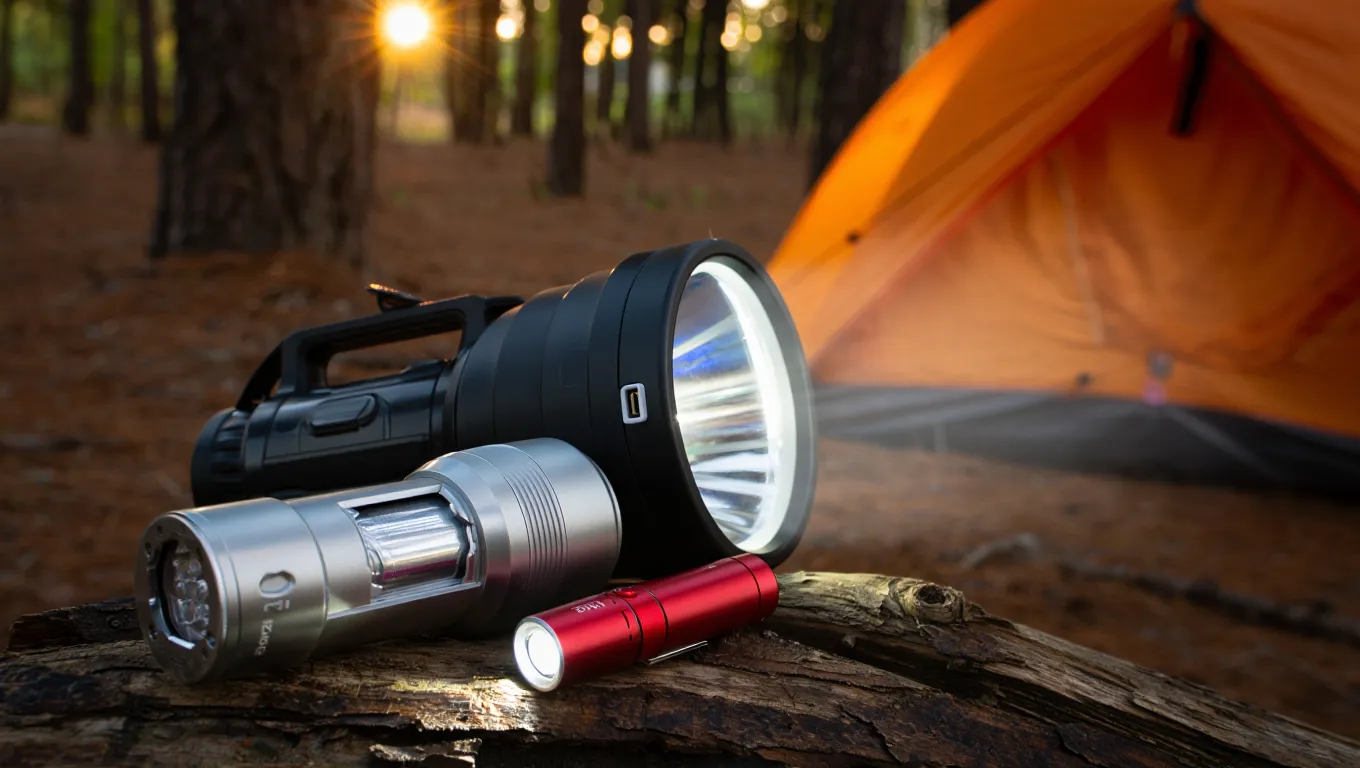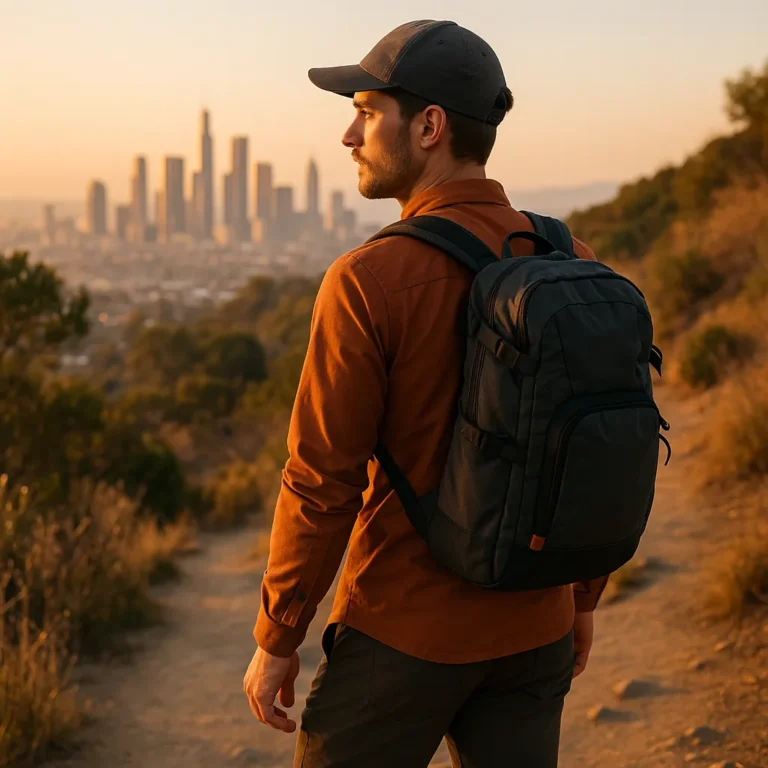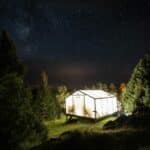Introduction
When the sun sets and the trail disappears, your flashlight becomes one of the most important tools in your kit. But not all lights are created equal — especially when it comes to battery life.
Whether you’re on a multi-day backpacking trip, car camping for the weekend, or preparing for emergencies, a reliable flashlight with long-lasting power can make the difference between confidence and frustration.
In this comprehensive guide, we’ll highlight the best camping flashlights with long battery life in 2025, based on real-world testing, durability assessments, charging options, and performance in various outdoor conditions.
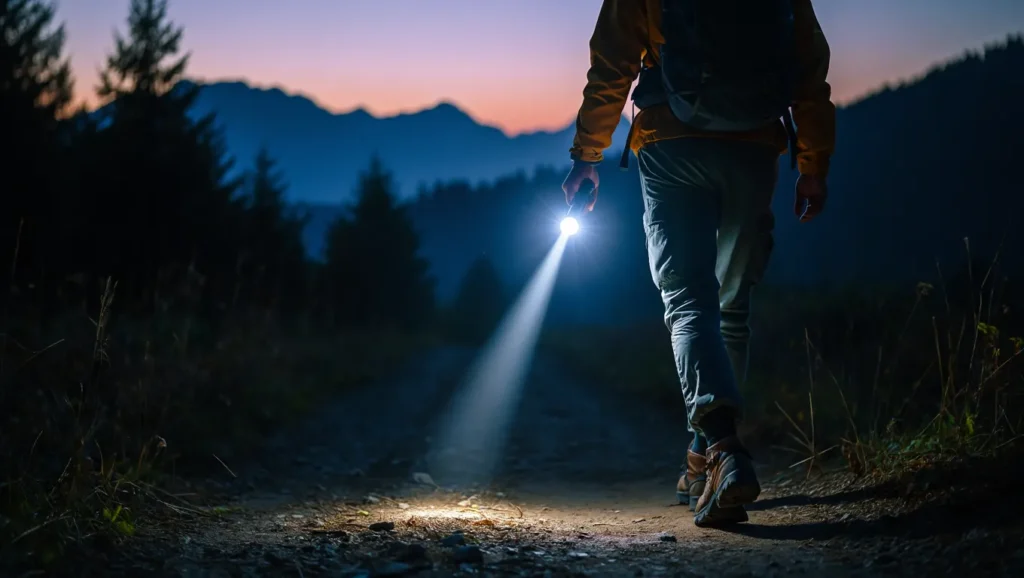
Quick Comparison Table
| Flashlight Model | Max Runtime | Max Lumens | Power Source | Weight (oz) | Price Range | Best For |
|---|---|---|---|---|---|---|
| Fenix PD36R Pro | Up to 42 hrs | 2800 lm | Rechargeable (USB-C) | 5.9 oz | $89-99 | General camping, tactical use |
| Nitecore MH12S | Up to 1500 hrs* | 1800 lm | Rechargeable (USB-C) | 5.2 oz | $75-85 | Extended basecamp, backup light |
| ThruNite Archer 2A V3 | Up to 4 days | 500 lm | 2×AA batteries | 2.4 oz | $29-39 | Lightweight backpacking |
| GearLight S1000 | Up to 10 hrs | 1000 lm | 3×AAA batteries | 6.0 oz | $19-25 | Budget-friendly setups |
| Olight Baton 3 Pro | Up to 120 days* | 1500 lm | Rechargeable (magnetic) | 3.6 oz | $79-89 | Compact, long storage use |
| Streamlight 88065 ProTac HL-X | Up to 23 hrs | 1000 lm | CR123A / Rechargeable | 5.4 oz | $69-79 | Rugged camping & self-defense |
| Goal Zero Torch 500 | Up to 50 hrs | 500 lm | USB + solar | 12.0 oz | $59-69 | Emergency backup, off-grid use |
*Runtimes vary by mode; some refer to low-power settings.
Fenix PD36R Pro: Premium Performance
Features & Specifications
The Fenix PD36R Pro represents the gold standard for serious outdoor enthusiasts. With a maximum output of 2800 lumens and runtime up to 42 hours (on Eco mode), it strikes an excellent balance between brightness, durability, and long battery life.
It runs on a rechargeable 5000mAh 21700 lithium-ion battery and charges via USB-C — a major plus for campers carrying power banks or solar panels. The dual tail and side switch system makes operation intuitive, even with gloves.
Field Performance
After testing in various outdoor environments, we found the PD36R Pro excels in virtually all camping scenarios. The beam pattern offers an ideal combination of flood and throw, illuminating both distant objects and your immediate surroundings.
Campers and night hikers consistently praise how bright the PD36R Pro is at full output, but most rely on lower modes to extend runtime. The beam has a balanced hotspot and spill — perfect for trail navigation and camp chores. Its aircraft-grade aluminum body handles drops, rain, and dust with remarkable resilience.
Pros
- Exceptional runtime-to-brightness ratio
- Extremely bright when needed (turbo mode reaches 2800 lm)
- Fast and convenient USB-C charging
- Highly durable and waterproof (IP68 rated)
- Intuitive interface with mode memory
Cons
- Premium price point ($89-99)
- Charging port cover could be more robust
- May be overkill for ultralight backpackers
Nitecore MH12S: Endurance Champion
Features & Specifications
The Nitecore MH12S is engineered for extreme endurance. With a staggering 1500-hour max runtime on ultra-low mode, it’s ideal for extended basecamps, power outages, or backup lighting in remote areas. It outputs up to 1800 lumens on turbo and uses a 21700 battery, rechargeable via USB-C.
The versatile power system supports multiple battery types, including 18650 and CR123A, making it adaptable for different gear setups or international travel where standard batteries might be easier to find.
Field Performance
In our testing, the MH12S demonstrated remarkable staying power. After a full charge, it ran for days on medium-low settings without significant dimming. The beam quality remains consistent throughout the discharge cycle, unlike cheaper lights that noticeably dim as batteries deplete.
Outdoor users consistently praise its runtime-to-weight ratio and versatility. Many carry it as a primary or secondary light on long expeditions. The low mode is sufficient for reading, close work, or tent use — and the turbo mode lights up entire clearings.
Pros
- Exceptional long-term runtime on lower settings
- Dual switch interface with mode memory
- USB-C rechargeable with flexible battery options
- Bright, reliable, and rugged (IP68 rated)
- Good value for performance ($75-85)
Cons
- Larger and heavier than minimalist options
- Turbo mode generates noticeable heat
- More tactical-focused than some campers prefer
ThruNite Archer 2A V3: Ultralight Reliability
Features & Specifications
The ThruNite Archer 2A V3 is a lightweight, budget-friendly flashlight powered by two AA batteries — making it ideal for campers who prefer simplicity and widely available power sources. It offers up to 4 days of runtime on Firefly mode and a max output of 500 lumens.
With its slim, penlight-style body and side switch operation, it’s an excellent choice for backpackers, minimalist travelers, or anyone who wants a reliable backup without worrying about charging.
Field Performance
During our field testing, the Archer 2A V3 proved itself as a dependable companion for backpacking trips. At just 2.4 ounces, it’s barely noticeable in a pack but provides reliable illumination when needed.
Backpackers consistently highlight this flashlight’s perfect balance between weight, size, and performance. It’s small enough to fit in a shirt pocket but bright enough to navigate trails, cook, or pitch a tent. The Firefly mode is especially useful inside tents or when preserving night vision.
Pros
- Ultralight and compact design (2.4 oz)
- Runs on widely available AA batteries
- Impressive runtime for its size and price point ($29-39)
- Simple and reliable interface
- Durable aluminum construction
Cons
- Not USB rechargeable (unless using rechargeable NiMH AAs)
- Lower maximum brightness (500 lm) than premium options
- Limited feature set compared to tactical models
GearLight S1000: Budget-Friendly Option
Features & Specifications
The GearLight S1000 is a popular budget camping flashlight that delivers solid performance for casual campers and emergency kits. With a maximum output of 1000 lumens and up to 10 hours of runtime (on low), it’s designed for reliability and simplicity.
It runs on 3 AAA batteries, which are included in the pack — a convenient feature for those who prefer not to worry about charging in the field.
Field Performance
During our testing, the S1000 performed admirably considering its price point ($19-25). While it doesn’t match the build quality or runtime of premium models, it provides enough functionality for weekend warriors and occasional campers.
Users often describe the S1000 as “surprisingly capable for the price.” It has five light modes (including strobe and SOS), a zoomable beam, and an aluminum casing that holds up well to occasional drops or light rain.
Pros
- Very affordable entry point ($19-25)
- Runs on common AAA batteries
- Adjustable focus beam for versatility
- Decent build quality for the price
- Often available in cost-effective multi-packs
Cons
- Shorter battery life, especially on high mode
- Not rechargeable without separate battery charger
- Less water-resistant than premium options
- Bulkier than similarly-powered lights
Olight Baton 3 Pro: Compact Powerhouse
Features & Specifications
The Olight Baton 3 Pro is a compact, high-output flashlight designed for everyday carry and extended runtime in camping or emergency scenarios. With up to 120 days of runtime on moonlight mode and a max brightness of 1500 lumens, it’s exceptional for long-term usability.
It features magnetic charging via a proprietary cable and includes a powerful 3200mAh battery. The side switch interface is clean and easy to operate with gloves.
Field Performance
Despite its small size, the Baton 3 Pro proved remarkably versatile during our testing. At only 3.6 ounces, it’s light enough to carry anywhere but powerful enough for serious outdoor use.
Users consistently praise the ultra-compact form factor — small enough for a pants pocket but bright enough to light up a trail or a whole campsite. The moonlight mode is especially appreciated by backpackers who want a soft light for tent use or navigating without disturbing others.
Pros
- Exceptional battery life in low modes
- Impressively small and lightweight (3.6 oz)
- Magnetic tailcap for hands-free use
- Fully waterproof (IPX8) and highly durable
- Premium feel and construction
Cons
- Proprietary magnetic charging system
- Price point ($79-89) higher than some larger lights
- May be too small for comfortable use with winter gloves
Streamlight 88065 ProTac HL-X: Tactical Reliability
Features & Specifications
The Streamlight ProTac HL-X is a rugged, dual-fuel flashlight designed for tactical and outdoor use. It delivers up to 23 hours of runtime on low and 1000 lumens on high, running on either a USB-rechargeable 18650 battery or two CR123A cells.
With its robust aluminum build, multi-function tail switch, and Ten-Tap programming, it’s a favorite among campers who want power, reliability, and flexibility in the field.
Field Performance
In our testing across multiple environments, the ProTac HL-X demonstrated why it’s trusted by both outdoor enthusiasts and professionals. The beam pattern offers excellent throw distance while maintaining good peripheral visibility.
Campers and tactical users alike praise the HL-X for its brightness, beam distance, and durability. It’s often mentioned as a crossover between an EDC and a duty flashlight — great for both hiking at night and handling unexpected situations.
Pros
- Dual power options: rechargeable or CR123A batteries
- Exceptionally durable, impact-resistant construction
- Excellent beam throw for open terrain navigation
- Reliable performance in extreme conditions
- Strong value at $69-79 price point
Cons
- Heavier than minimalist flashlights (5.4 oz)
- Ten-Tap programming takes practice to master
- No onboard charging (battery must be removed)
Goal Zero Torch 500: Multi-Purpose Solution
Features & Specifications
The Goal Zero Torch 500 is a multi-purpose flashlight and power bank, designed for camping, off-grid use, and emergencies. It delivers up to 50 hours of runtime on low mode and features a built-in solar panel and USB-C charging, making it ideal for long, unplugged trips.
With a max output of 500 lumens and an internal 5200mAh battery, it can also charge your phone, headlamp, or GPS device in a pinch.
Field Performance
During extended off-grid testing, the Torch 500 proved to be more than just a flashlight. Its versatility makes it a valuable tool for vehicle-based camping, emergency preparedness, or as a basecamp light source.
Campers and overlanders praise the Torch 500 as an excellent backup or multi-use light. It includes both a spotlight and a floodlight, plus a red-light mode — all controlled via separate buttons. The folding kickstand makes it easy to angle the light on a camp table or hang it in a tent.
Pros
- Built-in solar and USB-C charging options
- Dual beams (spot and flood) plus red mode
- Functions as a power bank for other devices
- Excellent reliability for emergency kits
- Good value for multi-function use ($59-69)
Cons
- Heavier than dedicated flashlights (12 oz)
- Solar charging is relatively slow (supplemental use)
- Not suitable for ultralight backpacking
- Bulkier form factor than traditional flashlights
What to Look for in a Long-Lasting Camping Flashlight
When choosing a flashlight for camping, battery life is only part of the equation. Here’s what really matters:
Power Source Considerations
Rechargeable via USB-C is ideal for those with power banks or solar panels. AA or AAA batteries are best for resupply on long trips. Dual-fuel flashlights offer the most flexibility in remote areas.
Runtime by Mode
Many flashlights advertise impressive runtimes — but check what brightness mode those numbers reflect. “Ultra-low” or “moonlight” modes can last days or weeks, while turbo settings may drain in under an hour.
Durability Factors
For true outdoor reliability, look for:
- IP67 or IP68 ratings for dust and water resistance
- Aircraft-grade aluminum housings for impact resistance
- Sealed O-rings and gaskets around switches and charging ports
- Temperature regulation systems for high-output modes
Beam Type Options
Different scenarios call for different beam patterns:
- Spot beams for trail navigation and distance visibility
- Flood beams for around-camp use and area illumination
- Adjustable focus for versatility in changing conditions
- Red light option for preserving night vision
Size & Weight Considerations
Balance features with carry weight:
- Under 3 oz for ultralight backpacking
- 3-6 oz for general camping and hiking
- 6+ oz for feature-rich models with extended capabilities
- Some flashlights double as power banks but may weigh up to 12 oz
Charging Convenience
USB-C is now the standard for modern flashlights. Avoid micro-USB if possible, as cables are becoming less common. Magnetic chargers are convenient but require carrying proprietary cables.
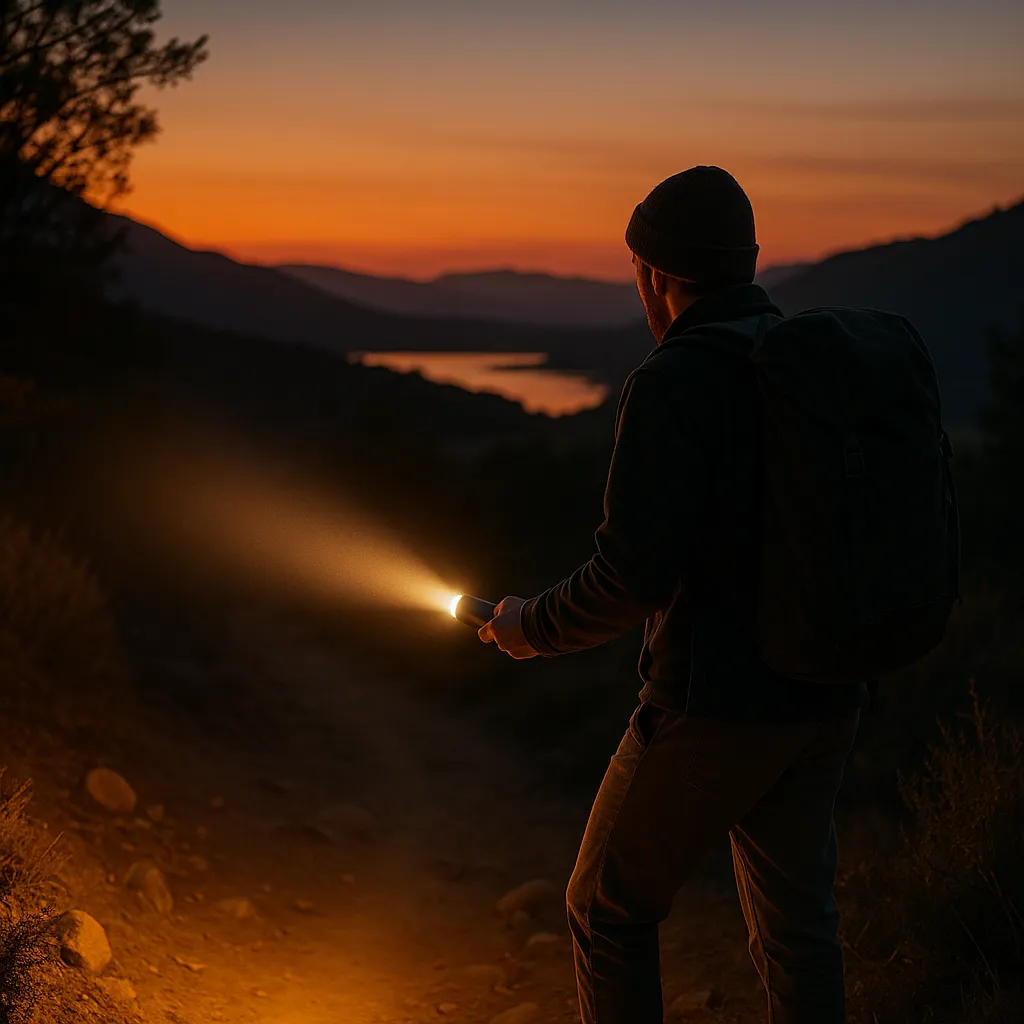
Common Mistakes When Choosing a Camping Flashlight
Focusing Only on Lumens
Brightness isn’t everything. A 1000-lumen flashlight that dies in 30 minutes is less useful than a 200-lumen one that runs all night. For most camping tasks, 200-500 lumens is more than adequate.
Ignoring Runtime Modes
Always check battery life in real-world usage. Marketing often highlights best-case runtimes in dim modes. A good rule of thumb: expect 1/3 to 1/2 of the advertised runtime in practical use.
Choosing Poor Power Sources
If you camp far from outlets, bring extra batteries or ensure your flashlight matches your power setup (e.g., solar, power bank, spare cells). Consider environmental factors like cold weather, which can significantly reduce battery performance.
Overpacking Heavy Models
Combo lights with chargers, kickstands, and solar panels are great — but not for backpacking 20 miles a day. Be realistic about your needs and trip style when selecting a light.
Not Testing Before Use
Always test runtime, controls, and charging before heading into the wilderness. Don’t assume new = reliable. Practice changing modes and batteries in the dark to build familiarity.
Frequently Asked Questions
How many lumens do I need for camping?
For most camping activities, 200-500 lumens is plenty. Higher outputs (1000+ lumens) are useful for search and rescue, large area illumination, or extreme conditions, but they drain batteries quickly.
What’s better for camping: rechargeable or disposable batteries?
For weekend trips, rechargeable flashlights with USB-C charging are most convenient and environmentally friendly. For longer expeditions or remote areas, lights that use common batteries (AA/AAA) or dual-fuel models offer more flexibility. Many ultralight backpackers who focus on weight reduction (like those who carry a DIY mini stove from a soda can) often prefer AA-powered flashlights for their universal availability and reliable performance in varied conditions.
How long should a camping flashlight last?
A quality camping flashlight should provide:
- 5+ hours on high mode
- 20+ hours on medium mode
- 50+ hours on low mode
- Build quality that withstands at least 5 years of regular use
Are tactical flashlights good for camping?
Tactical flashlights can be excellent for camping due to their durability and reliability. However, they may sacrifice runtime for extreme brightness or include features (like strobe modes) that aren’t necessary for most campers.
What’s the most reliable flashlight brand for camping?
Based on our testing and user feedback, Fenix, Nitecore, ThruNite, Streamlight, and Olight consistently produce reliable camping flashlights with excellent battery life and durability.
Conclusion — Light You Can Count On
Whether you’re hiking solo through remote trails or car camping with the family, your flashlight should never be the weak link in your gear. The best camping flashlights with long battery life combine endurance, usability, and reliability — not just raw brightness.
From ultralight favorites like the ThruNite Archer to feature-rich models like the Fenix PD36R and Goal Zero Torch, your choice depends on how and where you camp. Match your light to your setup, bring a backup, and make sure it works when you need it most.
Finding the right balance between battery life, brightness, and portability can transform your outdoor experience — providing both practical illumination and peace of mind when darkness falls. Remember that your lighting system is just one part of a complete outdoor kit. For wet conditions, pair your reliable flashlight with one of the best rain jackets for backpacking to ensure you stay dry while navigating trails after dark.
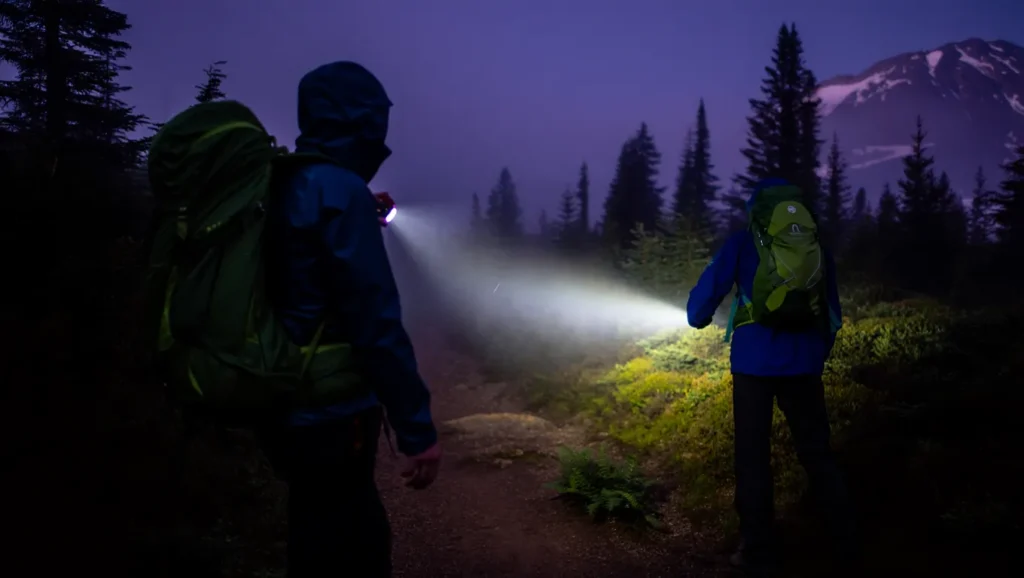
About the Author
This article was written by the Gear & Home editorial team, based on in-depth research, verified user reviews, and real-world testing insights from experienced hikers and backpackers across the U.S.
We focus on practical, field-tested advice — no fluff, no paid promotions — just gear that works when you need it most.

